The Birthstone for May 29: An In-Depth Exploration
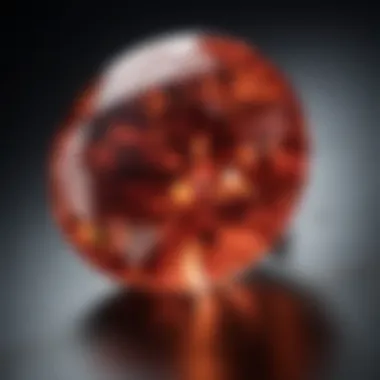
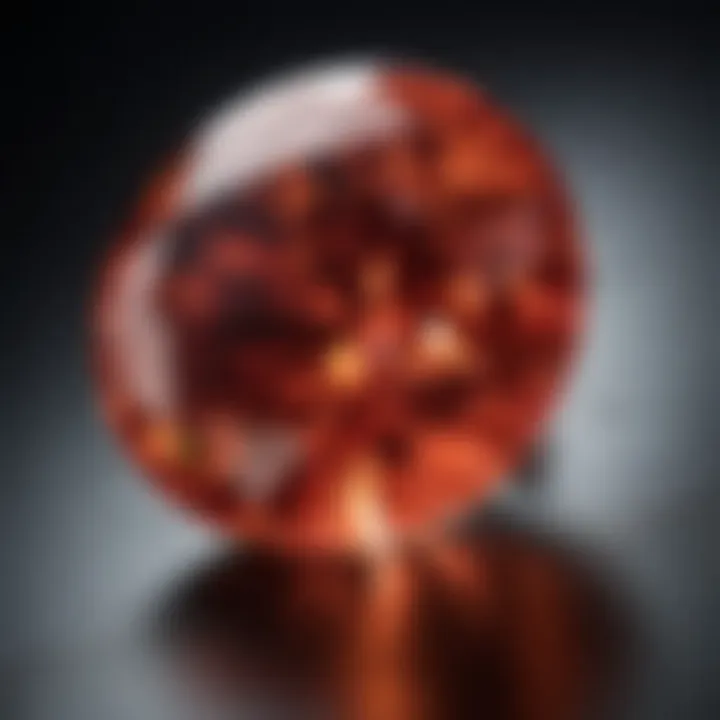
Intro
May 29 is associated with a unique and captivating birthstone, which holds considerable significance across various cultures and traditions. Understanding this gemstone goes beyond admiring its beauty; it encompasses an exploration of its origins, properties, and historical relevance. This section is designed to offer a grounding perspective before diving into deeper aspects of the gem.
Gemstone Overview
Definition and Origins
The birthstone for May 29 is Emerald. This green gem, recognized for its stunning color and clarity, belongs to the beryl family of minerals. The name "emerald" is derived from the Greek word "smaragdus," which translates to "green." The exceptional rich green hue of emeralds is primarily due to trace amounts of chromium and sometimes vanadium. Historically, emeralds have captured the attention of civilizations for thousands of years, revered for their rarity and vibrant color.
Historical Significance
Emeralds were held in high esteem by various ancient cultures. The Egyptians cherished them, viewing them as symbols of fertility and rebirth. Cleopatra, the famous queen, was known to have a deep love for these stones, often using them in her jewelry. In ancient Rome, emeralds were believed to provide protection against evil spirits and were associated with Venus, the goddess of love. These historical ties not only highlight the gemstone's beauty but also its cultural importance in shaping human experiences.
Gemstone Properties
Hardness and Durability
Emeralds, with a hardness of 7.5 to 8 on the Mohs scale, exhibit good durability. However, they are more prone to fracture compared to other gemstones due to their natural inclusions, which are often referred to as "jardin." To ensure longevity, it's crucial to handle emeralds with care, avoiding harsh chemicals and impacts that may lead to damage.
Color and Clarity
The most sought-after emeralds display an intense green color, which can vary from a bluish to yellowish hue. The color quality largely enhances the gem's value. Clarity is also essential; however, some inclusions are tolerated in emeralds, as they are a natural characteristic of the stone. When assessing an emerald's value, factors like color saturation, clarity, cut, and carat weight should be considered.
"Emeralds’ alluring green color and mystique have fascinated human beings for centuries, making them symbols of prestige and desire."
In summary, exploring the birthstone for May 29, an emerald, reveals a world rich in history and craftsmanship. Understanding its properties and significance elevates appreciation among gemstone enthusiasts, collectors, and jewelry designers alike. From ancient civilizations to modern times, the emerald continues to capture hearts and imaginations.
Understanding Birthstones
The concept of birthstones holds a significant place in various cultures, encapsulating not just beauty but also meaning and tradition. This article explores the role of birthstones, specifically focusing on the emerald as the birthstone for May 29. Birthstones serve as a personal token, linked to the month of one's birth, and they are often believed to provide individuals with certain benefits, such as protection and good fortune. Understanding their importance offers insight into both historical contexts and contemporary practices in gemstone appreciation.
Historical Overview of Birthstones
Historically, the tradition of birthstones can be traced back to ancient civilizations. The ancient Babylonians are often credited with associating specific gemstones with the twelve signs of the zodiac. This practice expanded through time, particularly as the biblical Book of Exodus references the twelve stones on the high priest's breastplate, each symbolizing a distinct tribe of Israel.
Many cultures adopted this practice, gifting gemstones that corresponded to their birth month. Over centuries, birthstones gained popularity in jewelry and personal ornamentation, reinforcing their role as symbols of identity and destiny. This historical background shapes our understanding of why certain gemstones, like emeralds, are tied to specific months.
Astrological Connections
Birthstones align closely with astrological beliefs. For the month of May, emeralds are often linked to the astrological sign of Gemini. Geminis are known for their duality, curiosity, and vibrant energy. The emerald, with its rich green hue, symbolizes rebirth, love, and harmony. Astrologers suggest that wearing an emerald can enhance communication, clarity of thought, and emotional balance for those born under this sign. Thus, understanding these connections between gemstones and astrological signs can provide insight into their perceived powers and influences.
Modern Interpretation of Birthstones
In contemporary society, the interpretation of birthstones has evolved significantly. They are not just regarded as personal symbols but are also seen in the context of fashion and self-expression. Consumers now seek birthstones not solely for their astrological relevance but for their rare beauty and the unique stories they tell. For example, the emerald is celebrated not only for its cultural heritage but also its physical characteristics, making it desirable for modern jewelry design.
"Birthstones serve as a bridge, connecting our present selves to traditions of the past while allowing individualized expression in contemporary life."
In addition, the rise of e-commerce and social media has influenced how birthstones are marketed and purchased. Enthusiasts are more informed about their choices, seeking knowledge about authenticity, origins, and ethical sourcing of gemstones. This shift reflects a broader consciousness about the implications of gemstone mining and its impact on communities.
As we delve deeper into the emerald’s distinct characteristics and significance, understanding the context of birthstones lays a foundation for appreciating their value across time and culture.
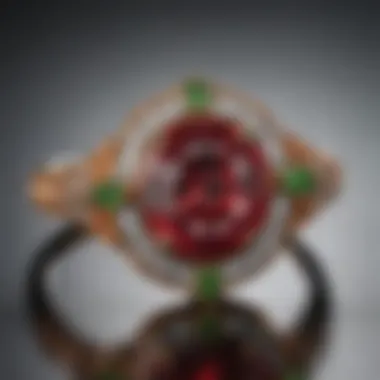
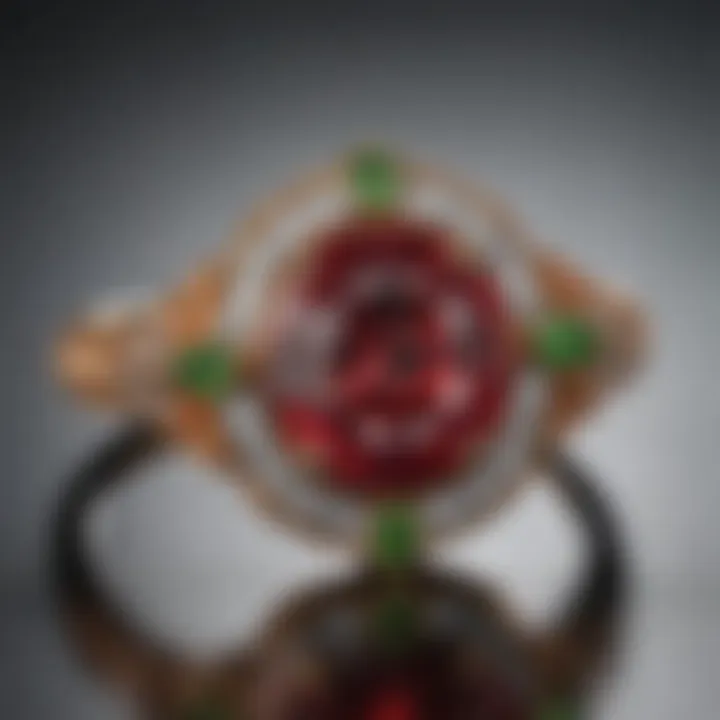
Birthstone for May: Emerald
Emerald is not just the birthstone for those born in the month of May; it signifies a rich history and a profound impact in various cultures. The emerald captivates both collectors and enthusiasts due to its vibrant beauty and notable rarity. In this section, we will delve into several elements that highlight the significance of emeralds.
Emerald is appreciated for more than just its aesthetic allure. It embodies concepts of renewal and growth. This connection is not just symbolic but rooted in ancient customs. From early civilizations to contemporary practices, the emerald has held a prominent role. Understanding its value involves looking at its origin, physical properties, and distinct color characteristics.
Emerald’s Origin and Etymology
The word "emerald" comes from the Latin term smaragdus, meaning green stone. This etymological root emphasizes the primary color associated with the gemstone. Historically, emeralds were mined in regions such as Egypt and South America. The famous Cleopatra, known for her affinity for emeralds, brought them into royal prominence. Other sources of emerald include Colombia and Zambia, which continue to produce stunning gems today.
Emeralds also hold mysterious qualities in various myths and folklore. In ancient times, it was believed that emeralds could reveal truth and protect against evil. This backdrop adds depth to the appreciation of this precious stone.
Physical Properties of Emerald
Emeralds are a variety of the mineral beryl, colored green by trace amounts of chromium and sometimes vanadium. The hardness of emerald is rated between 7.5 and 8 on the Mohs scale, making them relatively durable. However, the inclusion of natural fissures and the unique characteristics known as jardin can impact the value and appearance of individual emeralds.
One critical aspect of emeralds is their clarity. Unlike many other gemstones, some inclusions in emeralds can actually enhance their appeal. Collectors may seek stones with minimal visible inclusions, while others appreciate the natural beauty in each gem's imperfections. This variability is one factor that makes choosing an emerald a personal journey.
Color Variations and Characteristics
Emeralds are primarily recognized for their rich green hues. However, they can show a range of colors, from bluish-green to yellowish-green. The most sought-after emeralds exhibit a vivid, deep green tone, often referred to as emerald green. Factors like the location of the stone's origin often influence these nuances.
The saturation and tone of emeralds significantly affect their value. A high-quality emerald will display a pure, intense green without any excessive gray or yellow overtones. Additionally, the size of the emerald also contributes to its value; larger stones are rare and tend to command significantly higher prices.
Understanding these various characteristics is vital for both collectors and new buyers. It assists in making informed choices when purchasing emerald gemstones.
"Emeralds captivate many not only because of their beauty but also due to their unique qualities and storied history."
Overall, the emerald's significance revolves around its physical traits, historical roots, and enduring allure. This section serves as a fundamental basis for appreciating the emerald, leading us to explore its role in different cultures.
Emerald in Different Cultures
Emeralds have been highly regarded across civilizations for centuries. Their rich green hue and rarity have imbued them with significant cultural meaning. This section illuminates the various ways emeralds influenced societies, from ancient traditions to modern beliefs. Understanding these attributes not only enriches one’s appreciation of these gemstones but also highlights their lasting legacy.
Emerald in Ancient Civilizations
In ancient times, emeralds were esteemed by various cultures. The Egyptians believed that the emerald signified fertility and rebirth. They often associated it with the goddess Isis, who was linked to motherhood. Consequently, emeralds were frequently included in burial jewelry, signifying hope for afterlife renewal.
The Incas revered emeralds as sacred stones. They saw them as the embodiment of life and nature. The rulers were known to adorn themselves with emeralds, demonstrating power and divinity. In such societies, wearing an emerald was making a statement about one's social status and spiritual connection.
Furthermore, in ancient Rome, emeralds were said to bring foresight and promote love. Roman author Pliny the Elder noted their ability to reveal truth, thus augmenting their esteemed position among gemstones.
Emerald in Modern Lore and Folklore
In contemporary culture, emeralds are perceived as symbols of hope, renewal, and growth. They are often associated with spring, resonating with new beginnings. A popular belief among many is that emeralds foster harmony and balance in relationships.
Additionally, various cultures attribute healing properties to emeralds. For example, some believe that they enhance mental clarity and relieve emotional stress. This connection to healing continues to be significant in metaphysical practices today.
In jewelry design, emeralds remain a popular choice. From royal crowns to casual jewelry, they signify luxury and elegance. Celebrities often wear emeralds during high-profile events, reinforcing their status as gems of quality and distinction.
"Emeralds have traversed time, connecting ancient wisdom with modern values, shaping not just adornments but also cultural identity."


The emerald's story in different cultures showcases its multifaceted nature. Its implications in history and modern practices reveal why these gemstones continue to capture human imagination. Understanding this history strengthens the bond between the stone and its admirers, making it more than just a gemstone but a piece of cultural heritage.
Metaphysical Properties of Emerald
Emeralds are not only cherished for their beauty, but also for their metaphysical properties. Many cultures have attributed significant spiritual and healing qualities to this vibrant green gemstone. Understanding these properties is essential for anyone interested in the deeper significance of emeralds. This section explores the key elements associated with the metaphysical properties of emeralds.
Healing Properties
Emeralds have long been recognized for their purported healing abilities. Various belief systems link the stone to physical health benefits, particularly relating to the heart and eyes. According to crystal healing traditions, emeralds are said to promote healing, balance, and harmony in one’s life.
- Physical Healing: It is believed that emeralds assist in detoxification of the body, strengthening the immune system. Some claim these stones can help alleviate issues like headaches, asthma, and digestive problems.
- Emotional Healing: Beyond the physical, emeralds are thought to soothe emotional turbulence. They may foster reflection and promote a sense of peace, making them conducive for meditation and self-discovery. Many practitioners advocate using emeralds to foster a positive mindset and emotional clarity.
In many healing practices, wearing or carrying an emerald can be a daily ritual to invoke these calming effects. However, it’s important to remember these healing properties are not substantiated by scientific evidence but are approached through cultural beliefs and traditional practices.
Emerald and Heart Chakra
The emerald is closely linked to the heart chakra, which is the center of love, compassion, and emotional connection. It is believed that this gemstone resonates well with the properties of the heart chakra, enhancing one's ability to give and receive love.
- Balancing Emotions: When the heart chakra is balanced, individuals may find themselves more open to love and compassion. Emeralds can aid in the alignment of this chakra, fostering emotional stability and harmony.
- Strengthening Relationships: Many believe that carrying or wearing emerald enhances empathy and understanding in personal relationships. This gemstone may help in strengthening the bonds with loved ones, both romantic and platonic.
- Self-Acceptance: Wearing emeralds is said to encourage self-love and acceptance. This can be particularly beneficial for those struggling with self-esteem or emotional wounds.
"Emeralds symbolize rebirth and love, making them powerful tools in personal transformation."
Care and Maintenance of Emerald Jewelry
Emeralds are renowned for their lush green color and rarity, making them highly coveted in the world of gemstones and jewelry. Proper care and maintenance of emerald jewelry are essential not just for aesthetic appeal, but also for preserving the stone’s integrity and value over time. Emeralds are more prone to scratches and damage due to their natural inclusions, which means that understanding how to care for them can significantly enhance their longevity.
Cleaning Techniques
When it comes to cleaning emerald jewelry, a careful approach is crucial. Here are some effective techniques to keep your emeralds looking pristine:
- Mild Soap and Water: Create a mixture of lukewarm water and a few drops of mild dish soap. Using a soft cloth or a soft-bristle toothbrush, gently clean the emerald. Rinse thoroughly under running water.
- Avoid Harsh Chemicals: It is important to avoid harsh cleaning agents or ultrasonic cleaners, as these can damage the stone and worsen its clarity.
- Soft Cloths for Drying: After washing, use a soft microfiber cloth to gently dry the emerald. This prevents scratches that may occur from rough fabrics.
"Emeralds require a gentler touch during cleaning compared to other gemstones, emphasizing the need for careful maintenance."
Regular cleaning can help maintain the stone’s sparkle and brightness. However, do not clean emerald jewelry too frequently. Once every few months is typically sufficient, as excessive cleaning may wear down the surface over time.
Storage Recommendations
Storage is equally important in preserving the quality of emerald jewelry. Here are some key considerations:
- Separate from Other Jewelry: Store emeralds separately from other gemstones, especially harder stones, to prevent scratches. Use individual compartments or soft pouches.
- Avoid Direct Sunlight: Keep emerald jewelry in a dark or cool place to avoid exposure to excessive sunlight, which can lead to color fading.
- Use a Jewelry Box: A lined jewelry box can provide protection and help keep your pieces organized. Ensure that the box is kept in a stable environment without humidity fluctuations.
- Keep Away from Heat Sources: Storage areas should avoid proximity to heat sources. Heat can affect the durability of emeralds and their settings.
Following these care and maintenance guidelines will help in preserving the beauty and value of emerald jewelry, ensuring it remains a cherished piece for years to come.
Purchasing Emeralds: What to Consider
When it comes to acquiring emeralds, a thoughtful approach is pivotal. Understanding the nuances of purchasing emeralds can enhance not only the buying experience but also ensure that the investment holds value and authenticity. This section explores the critical elements that one should consider before making such a significant purchase.
Understanding Grading Metrics
Emeralds, like other gemstones, are evaluated based on a set of grading metrics known as the 4Cs: Color, Clarity, Cut, and Carat weight.
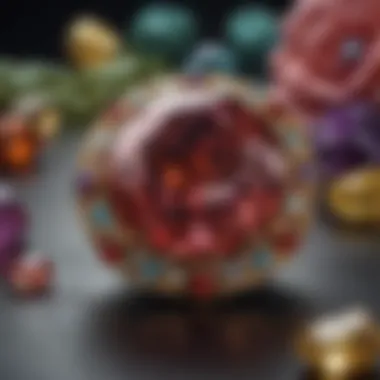
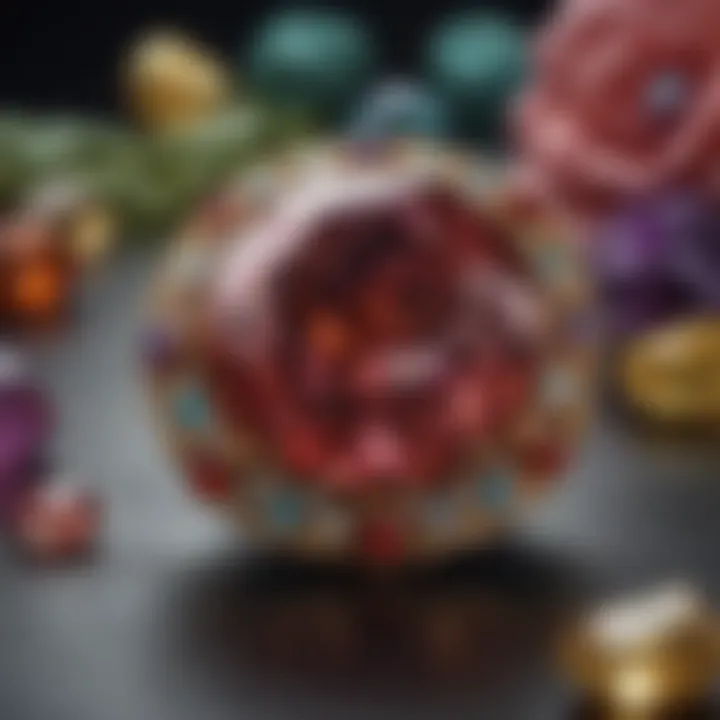
- Color: This is often the most important factor. High-quality emeralds exhibit a vibrant green color, with variations ranging from bluish-green to yellowish-green. The most sought-after emeralds are those that display a vivid and intense color.
- Clarity: Emeralds typically have inclusions, often referred to as natural characteristics or "garden." However, less included stones are more valuable. The clarity will affect the stone's appearance and ultimately its price.
- Cut: Unlike diamonds, emeralds are traditionally cut into rectangular shapes known as "emerald cuts." This facets' arrangement enhances the gem's color while reducing the risk of breaking. A well-cut emerald will reflect light beautifully and highlight its rich hues.
- Carat Weight: Larger emeralds are rarer and usually more prized. However, size alone does not dictate quality. Often, smaller emeralds can be more eye-catching due to better color and clarity.
Each of these metrics plays a vital role in determining the emerald's value and beauty. Hence, a knowledgeable buyer should focus on balancing these factors instead of seeking the largest stone without considering quality.
Sources and Authenticity
The source of an emerald can significantly influence its value. Practices in the gem industry vary, and reputation is paramount. Here are key points to consider regarding sourcing and authenticity:
- Origin: Colombian emeralds are often viewed as the gold standard due to their rich color and fewer inclusions. However, emeralds from Brazil and Zambia also present unique color and clarity attributes. Knowing the origin is essential in understanding the market value.
- Certificates: Reputable dealers often provide certificates from recognized gemological laboratories like the Gemological Institute of America (GIA) or the International Gemological Institute (IGI). These documents confirm the stone's identity, grading, and authenticity.
- Retailer Reputation: Selecting a trusted retailer is crucial. Researching their background, customer reviews, and industry affiliations can help assure that they operate ethically and are knowledgeable in their field.
- Traceability: Some stones now come with blockchain technology that provides a transparent history of the stone's journey. This traceability can affirm that the gem is conflict-free, an increasingly important consideration for many buyers today.
In summary, delving into grading metrics and ensuring the authenticity of emeralds are crucial steps for any buyer. These considerations not only protect the investment but also enhance appreciation for the unique beauty of these gems.
Emerald in Jewelry Trends
The significance of emeralds in modern jewelry trends cannot be understated. Collectors and casual buyers alike appreciate the unique beauty and historical context that emeralds offer. In this section, we will discuss the current styles and designs showcasing emeralds in jewelry, as well as the influence of celebrities in shaping these trends. By understanding these trends, readers can gain insights into the evolving landscape of emerald jewelry, which enhances both its aesthetic appeal and investment value.
Current Styles and Designs
Emerald jewelry has made a notable resurgence in recent times, largely due to its rich green hue and exquisite clarity. Today's designers are exploring innovative approaches to incorporate emeralds into their collections.
- Solitaire Pieces: Simple yet striking, solitaire emerald rings continue to be popular. These pieces often showcase a single, high-quality emerald, allowing the stone to shine without distraction.
- Mixed Gemstone Designs: Combining emeralds with other stones, like diamonds or rubies, creates vibrant contrasts. Designers emphasize pairing emeralds with either classic or unconventional gemstones.
- Sustainable Jewelry: Many consumers are now seeking pieces that reflect ethical sourcing. As a result, brands emphasize their commitment to sourcing conflict-free emeralds and eco-friendly practices, making this a key selling point.
- Vintage and Art Deco Styles: Vintage-inspired pieces have found new fans. Art Deco designs, characterized by geometric patterns and bold colors, frequently use emeralds to amplify their lavish aesthetic.
- Customized and Personalized Jewelry: Many consumers are interested in customization. Using emeralds in tailored designs illustrates personal stories, making these pieces more special.
Emeralds are not just timeless; they adapt to modern tastes while retaining their classic allure. In their various forms, these gems continue to resonate with gemstone lovers.
Emerald in Celebrity Jewelry
Celebrities often play a crucial role in popularizing specific jewelry trends. Emeralds have frequently graced red carpets and high-profile events, capturing the attention of fashion enthusiasts and collectors alike.
Several noteworthy instances include:
- Celebrity Engagement Rings: A few celebrities have opted for emerald engagement rings, signaling a shift away from traditional diamonds. This trend allows for a more personalized and unique touch.
- Award Shows: At events like the Oscars or Golden Globes, stylists often adorn stars with exquisite emerald pieces, highlighting their beauty on global platforms. Such choices inspire fans and budding stylists to embrace emerald jewelry.
- Social Media Influence: Platforms like Instagram and Pinterest have made it easier for fans to spot their favorite stars. When a notable figure is seen wearing emeralds, it often leads to a spike in demand for similar designs.
"Emeralds are timeless symbols of sophistication, favored by those seeking distinctive elegance in their jewelry choices."
By observing how celebrities incorporate emeralds into their wardrobes, enthusiasts can identify lasting trends and gain inspiration for their own collections. Given the gemstone's enduring allure, it is likely that emeralds will continue to remain a favorite in jewelry trends.
End
The conclusion of this article serves to emphasize the significance of emeralds, particularly as the birthstone for May 29. Each gem has stories tied to culture, history, and personal symbolism. Emeralds, with their lush green hues, evoke deep emotions and represent renewal, growth, and vitality. It is vital to recognize that beyond mere aesthetics, these stones hold value in various traditions and spiritual practices.
Emeralds are not just a feast for the eyes; they require understanding and care. Knowing how to maintain their beauty and integrity can greatly enhance one’s appreciation for them. This demand for care directly correlates with the bond one can form with this gem. By adopting proper maintenance habits, collectors and casual wearers alike can enjoy the longevity of their emerald pieces.
Furthermore, the purchasing aspects discussed throughout the article guide readers toward informed decisions. Knowledge about grading, authenticity, and sourcing ensures a more fulfilling acquisition experience, reducing the risk of regret. Navigating the emerald market can be daunting without the right tools, but this exploration provides foundational insights that empower buyers.
In summary, the allure of emeralds lies not only in their beauty but also in their rich tapestry of meanings and the care they deserve. Understanding these aspects enhances one’s relationship with this gemstone, making it a cherished part of one’s life.
The Enduring Allure of Emeralds
Emeralds possess a timeless appeal that transcends generations. Their mesmerizing color and unique characteristics resonate with people across many cultures. Often associated with fertility, rebirth, and love, these stones carry powerful connotations.
In historical contexts, emeralds were favored by royalty and have appeared in the treasures of ancient civilizations. The ancients believed emeralds could bestow wisdom and protection. Such perceptions, while rooted in history, continue to shape modern appreciation for emeralds.
Emeralds also hold a place in contemporary jewelry design. Their distinct hue complements various styles and occasions, enhancing elegance. Popular among jewelry designers, emeralds can be found in everything from classic pieces to modern avant-garde creations. Their versatility ensures they remain relevant in today’s fashion landscape.
Moreover, a psychological aspect exists. The vibrant green of emeralds can evoke feelings of calm and rejuvenation. As more people turn towards holistic wellness practices, the emotional and spiritual aspects tied to emeralds gain traction.
Collectively, these factors contribute to the enduring allure of emeralds. They are far more than just gemstones; they embody history, culture, beauty, and emotion, standing as a rich symbol of human experience.



